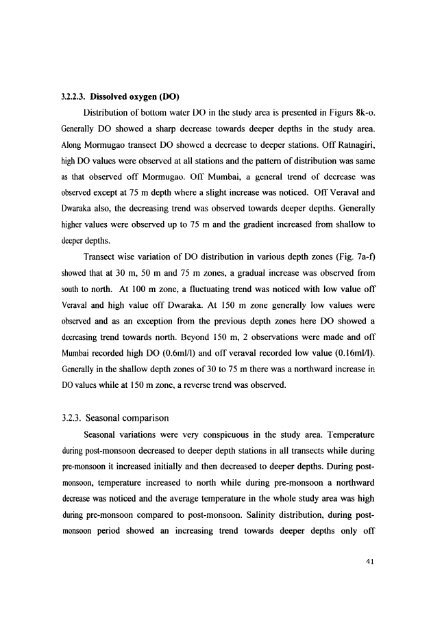L - Cochin University of Science and Technology
L - Cochin University of Science and Technology
L - Cochin University of Science and Technology
Create successful ePaper yourself
Turn your PDF publications into a flip-book with our unique Google optimized e-Paper software.
3.2.2.3. Dissolved oxygen (DO)<br />
Distribution <strong>of</strong> bottom water DO in the study area is presented in figurs 8k-o.<br />
Generally DO showed a sharp decrease towards deeper depths in the study area.<br />
Along Monnugao transect DO showed a decrease to deeper stations. Off Ratnagiri,<br />
high DO values were observed at all stations <strong>and</strong> the pattern <strong>of</strong> distribution was same<br />
as that observed <strong>of</strong>f Monnugao. OLT Mumbai, a general trend <strong>of</strong> decrease was<br />
observed except at 75 m depth where a slight increase was noticed. OfT Veraval <strong>and</strong><br />
Dwaraka also, the decreasing trend was observed towards deeper depths. Generally<br />
higher values were observed up to 75 m <strong>and</strong> the gradient increased from shallow to<br />
deeper depths.<br />
Transect wise variation <strong>of</strong> DO distribution in various depth zones (Fig. 7a-f)<br />
showed that at 30 m, 50 m <strong>and</strong> 75 m zones, a gradual increase was observed from<br />
south to north. At 100 m zone, a fluctuating trend was noticed with low value <strong>of</strong>f<br />
Vcraval <strong>and</strong> high value <strong>of</strong>f Dwaraka. At 150 m zone generally low values were<br />
observed <strong>and</strong> as an exception from the previous depth zones here DO showed a<br />
decreasing trend towards north. Beyond 150 m, 2 observations were made <strong>and</strong> <strong>of</strong>f<br />
Mumbai recorded high DO (0.6ml/l) <strong>and</strong> <strong>of</strong>f veraval recorded low value (0.16ml/l).<br />
Generally in the shallow depth zones <strong>of</strong> 30 to 75 m there was a northward increase in<br />
DO values while at 150 m zone, a reverse trend was observed.<br />
3.2.3. Seasonal comparison<br />
Seasonal variations were very conspicuous in the study area. Temperature<br />
during post-monsoon decreased to deeper depth stations in all transects while during<br />
pre-monsoon it increased initially <strong>and</strong> then decreased to deeper depths. During post<br />
monsoon, temperature increased to north while during pre-monsoon a northward<br />
decrease was noticed <strong>and</strong> the average temperature in the whole study area was high<br />
during pre-monsoon compared to post-monsoon. Salinity distribution, during post<br />
monsoon period showed an increasing trend towards deeper depths only <strong>of</strong>T<br />
41

















